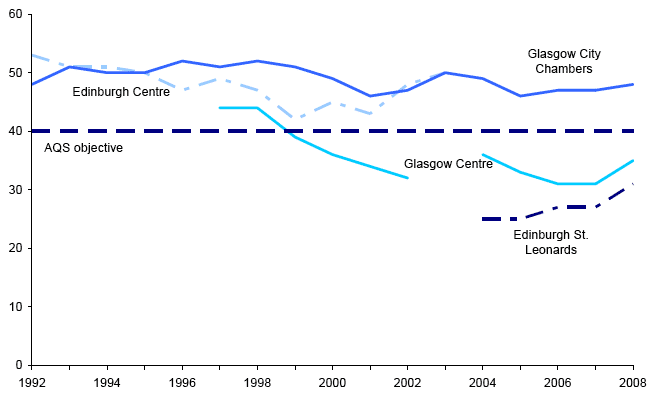Key Scottish Environment Statistics 2009
Annual publication containing summary of key statistics on environmental trends in Scotland
Air Quality
Nitrogen dioxide concentrations: 1992-2008
Annual mean concentrations (µg/m 3)

Annual mean concentrations (µg/m 3)
Site 5 |
1992 |
1995 |
2000 |
2005 |
2006 |
2007 |
2008 |
|---|---|---|---|---|---|---|---|
Glasgow Centre 6 |
- |
- |
36 |
33 |
31 |
31 |
35 |
Glasgow City Chambers |
48 |
50 |
49 |
46 |
47 |
47 |
48 |
Edinburgh 2 |
53 |
50 |
45 |
25 |
27 |
27 |
31 |
High concentrations of nitrogen dioxide (NO 2) can affect human health, particularly by causing inflammation of the airways. Ecosystem health is also damaged by NO 2 by contributing to acid deposition, eutrophication and promoting the formation of ground level ozone.
All combustion processes in air produce oxides of nitrogen (NO X). Road transport accounted for 32% of all UK NO X emissions in 2006; this contribution is greatly increased in urban areas. Between 1990 and 2006, UK emissions of NO X are estimated to have decreased by 49% 3, due in part to the installation of catalytic converters in vehicles.
The Air Quality Strategy 4 objectives for NO 2 (to be met by the end of 2005) are (1) an annual mean of 40µg/m 3 and (2) an hourly mean of 200µg/m 3 not to be exceeded more than 18 times a year. In 2008, the first objective was not met at 16 of the 50 automatic monitoring sites in Scotland, those failing included Aberdeen Roadside, Glasgow City Chambers and Glasgow Kerbside. The second objective was met at all but 6 automatic monitoring sites, Glasgow Kerbside and Aberdeen Roadside were amongst those who failed, they recorded exceedences of 72 and 20 respectively.
Source: Scottish Air Quality Database
There is a problem
Thanks for your feedback